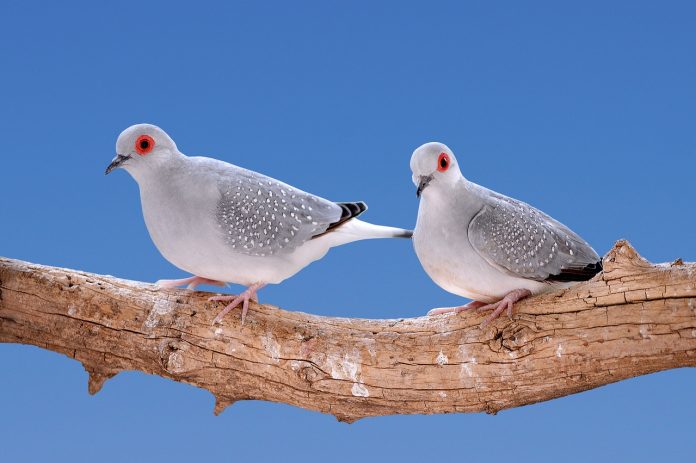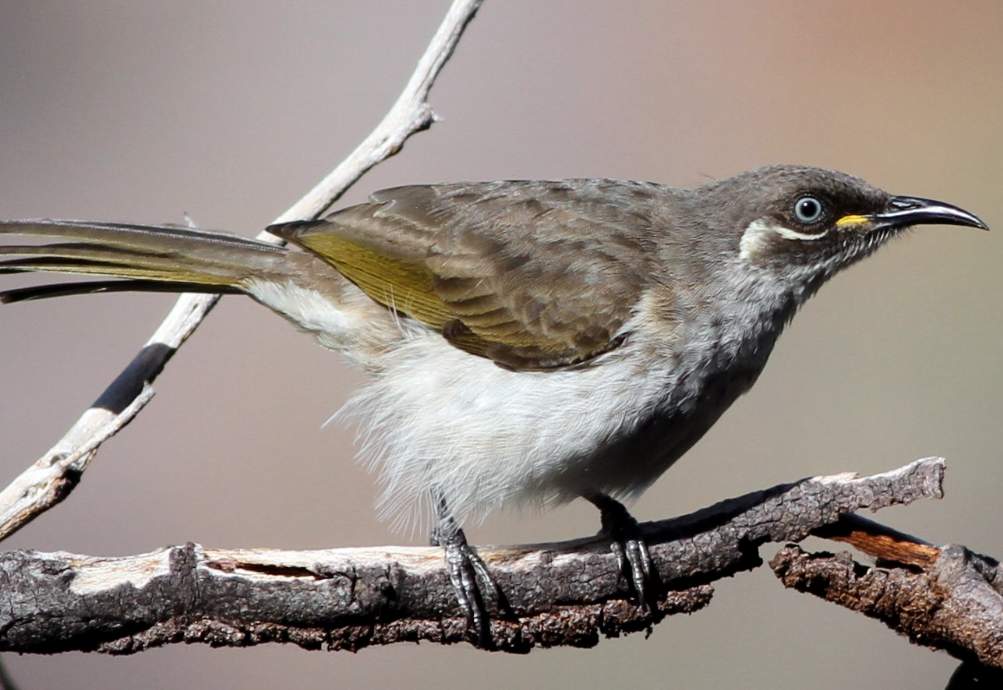Description: The diamond dove (Geopelia cuneata) is the smallest member of the pigeon family. The red-eye dove is widely distributed in Australia but is essentially a bird of the semi-arid zone near the water area. It is particularly commonly spotted in dry (Gardens and Parks of Southern Australia) open savannas in mulga areas. It must have access to water and some trees for nesting and roosting.
Behavior and Habitats: The sexual displays of the Diamond Dove are similar to those of other members of the genus Geopelia. However, in the bow, it raises its tail vertically, much higher than the other species. In arid regions, diamond doves are nomadic and move in large numbers from place to place, seeking out areas where rain has fallen.
Usually, diamond doves live in small groups, but in the early morning, hundreds of birds may gather at the water. Before dawn, at desert waterholes, the air is filled with a soft cooing as the birds await sunrise before going to drink. Most drinking, nevertheless, is done in the later afternoon.
The doves often arrive in procession, with each bird walking to the water’s edge, submerging its bill, and sucking to imbibe its fill before flying off to make way for the next. In times of drought in the interior, the populations disperse. Many of the small local flocks that live in well-watered districts towards the coast probably have arisen from past invasions and are not necessarily permanent there.
Identification: The male head and neck are pale blue-grey; the back, rump, and upper side of the slender tail are delicate grey-brown; the outer tail feathers are tipped very extensively white. Throat and breast pale blue-grey; lower breast and underside of tail white. Upperside of wings: brown-grey spotted liberally with white spots; under shoulders: grey-brown; flight feathers: chestnut. The eye and skin around the eye are red, the bill is light gray, and the feet are pink.
The female bird is similar to the male but a bit duller and browner on the foreparts. Moreover, the immature birds’ upper pares are brown with obscure dusky and grey flecking. Throat and breast grey with darker brown scalloping; lower breast and belly light brown. Eye and skin around the eye are fawn; the bill is gray with legs grayish. Also, the downy young is similar to sand-colored.
Heat Absorption: The diamond dove has an exceptional tolerance level to absorb extreme heat due to its perfect body temperature, water balance, behavior, metabolism, and respiration. They are often seen sitting on the electric wires in the scorching heat.
Feeding: Diamond doves feed on the ground to eat ants and almost entirely on very small seeds from a wide variety of drought-evading ephemeral plants, mostly herbs and grasses. But it feeds and spends much of its time on the ground. When feeding, the Diamond Dove walks with a slow and regular gait, although it can run quite fast with a wobble, holding its long tail up and away from the ground.
In central Australia, the most important source of seeds is Glinus lotoides, which provides more than a quarter of the bird’s total diet. Diamond doves also eat a little green material and, occasionally, insects, which can be a very significant addition to their diet in some months.
Flight: Its flight is swift and direct but has a swooping character over long distances as the bird alternately beats its wings rapidly (frrrr noise), closes them for a moment, and also runs for a waddling gait. Flight is sometimes undulating.
Call/Sound/Song: – The diamond dove is famous for a number of different calls. The call is a bit sad mournful, soft coo-oo, coo-oo, and shorter, and sometimes louder, corr-coo. However, explosive coo in bowing display The alarm call is short but loud.
Length: The bird’s average size is 195-215 mm.
Nesting: Most males are in a state of sexual readiness throughout the year; breeding possibly peaks in September–November or after heavy rain. A nest is a rail platform up to 50 mm in diameter, made with fine twigs or interwoven grass stems but fragile in construction, placed in the low fork of a tree.
Breeding: Normally, the clutch contains two eggs, which are smooth and white and ellipsoidal, 20 x 15 mm. The incubation period is about 13 days for both sexes. The chick is fast-growing, fully feathers quickly, and fledges in 12–15 days.
Distribution: It is found in northern and central Australia, where it is nomadic; it occurs in arid and semi-arid zones, where rainfall exceeds 300 mm a year. No races.
Status: The Victorian Flora and Fauna Guarantee Act 1988 has listed Diamond Dove as near-threatened. Hence, it is highly advised to take preventative actions for the future care of this species.
Other Names:
English: Little Turtledove, Red-eyed Dove
Dutch: Diamantduif
German: Diamanttäubchen
Spanish: Tortolita Diamante,
French: Colombe diamant,
Norwegian: Diamantdue
Turkish: Minyatür kumru
Russian: Бриллиантовая горлица,

Also, Read = Mountain Avocetbill






